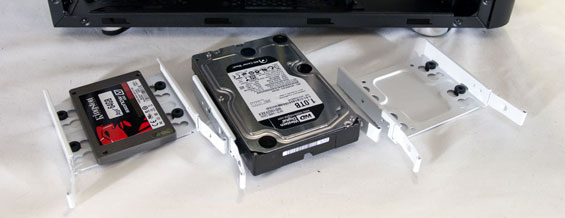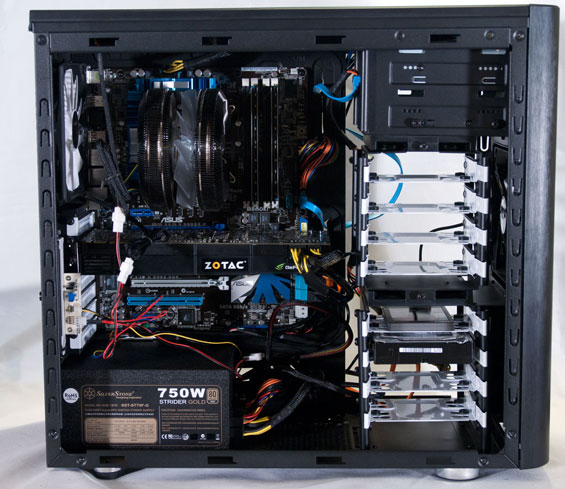Fractal Design Arc Midi: The Mid Tower You've Been Waiting For?
by Dustin Sklavos on October 7, 2011 12:45 AM EST- Posted in
- Cases/Cooling/PSUs
- mid-tower
- Fractal Design
Assembling the Fractal Design Arc Midi
While the Fractal Design Arc Midi does feature a very smart internal design, there are a couple of small conveniences that are missing, the first of which being built in mounting studs for the motherboard. This is a simple thing, but can prove to be a minor nuisance should you ever replace the motherboard: if you don't put the studs in securely the first time, they're liable to join the motherboard when you try to remove it.
Still, getting the motherboard in was easy (as it often is), though routing the AUX 12V cable has been and almost always will be a royal pain. And while it looks like the enclosure is capable of supporting a 240mm radiator, clearance above the motherboard is pretty tight as it is, so I wouldn't recommend it.

None of the drive bays or sleds are tool-less either. This is one area where Corsair has a slight lead, as their plastic drive sleds are actually pretty effective at keeping 3.5" drives in place. At the same time, though, the more traditional drive sleds do come complete with silicon grommets for 3.5" drives, and each sled has mounting holes for 2.5" drives directly in the center of the sled. Getting the hard drive, SSD, and optical drive in was easy enough, it just required a bit of elbow grease and the use of a screwdriver.
Video card clearance even in the native configuration of the top drive cage was also perfectly fine; our GeForce GTX 580 had plenty of breathing room between it and the cage. Getting the power supply in was a breeze too, although it's worth noting that if you use a PSU longer than 170mm you run the risk of covering up the bottom intake fan bay. Most users won't care but it's something to keep in mind.

Getting everything wired up was actually fairly breezy for the most part; the case's interior feels smaller than Corsair's cases which makes things a little more cramped, but it was still easy enough to work with. Where things got cagey was the installation of the expansion slot-based fan controller. My advice here is simple: if your motherboard has decent fan control and enough connectors to support the Arc Midi, just use it instead. The wiring for the fan controller really messes up what would otherwise have been a fairly clean interior. The fan controller has a breakout cable that splits into a molex and three three-pin fan plugs, and I'm not sure there's any good place to put it that isn't going to have you running fan cables all the heck over the system. It's certainly impossible to route those cables behind the motherboard tray, where Corsair wisely stashes theirs in the enclosures that include fan controllers, but you'll need long enough fan cables and it's still a bit of a pain.

Yet to be fair, Fractal Design does provide a tremendous amount of space behind the motherboard tray. In many other builds you'll often find yourself having to lay the case down on its side, then applying a bit of pressure and force to slide the panel back on. That doesn't happen with the Arc Midi: be as sloppy as you want to back there, nobody's going to notice and it's not going to seriously affect your ability to get the case shut.
Under the circumstances I'm liable to regard the fan controller as a "bonus" more than anything else. Without it mucking up the cabling, the interior of the Arc Midi is actually fairly well thought out and organized, easy enough to put together (although ever so slightly more difficult than the Corsair cases we've reviewed). I'm extremely pleased with the space for two 140mm intake fans, and the top one actually does get fairly closely in line with the CPU fan. Given how 5.25" drive bays are becoming progressively less and less relevant, I'd take the sacrifice as a net win.
















52 Comments
View All Comments
beginner99 - Friday, October 7, 2011 - link
I'm quiet surprised about the noise. I'm not sure that buying new fans helps much. i have the fractal R2 and those fans are inaudible, ok they don't have very good air flow but still. The noise comes from the GPU and probably cpu cooler and not the case fans and hence replacing them will mainly help improve cooling.But then if you want quiet you would not buy this case anyway.
Iketh - Friday, October 7, 2011 - link
For some reason, this article got me thinking about tiptronic fans... what happened to them?? I can't find in google searchesKepe - Friday, October 7, 2011 - link
I strongly recommend you guys at Anandtech check out and review the Define R3. The internal and external layouts are pretty much identical despite differing aesthetics on the outside. What the R3 has over the Arc Midi, though, is noise insulation all over the case. It also has removable noise insulation pieces for those fan intakes and exhausts that are not occupied by a fan. This way you can choose to have a VERY quiet case, or a very well ventilated case that is still quite quiet.I have the R3 with 2 intake fans in the front, 1 intake fan at the bottom and 1 exhaust fan at the back. This creates a nice overpressure that ensures there is minimal dust build-up in the case. When idling, the computer is very quiet. So quiet in fact, that when I come home from somewhere, I can't even hear if the thing is turned on or off (I have a small 1 room apartment). Also the thermals are astonishing. My Gigabyte GTX 560 Ti runs at 34 degrees Celsius when idle, and never reaches 75 degrees Celsius in Furmark.
The Define R3 cost me 75€ here in Finland (and we have huge taxes on everything), so I think it should be in the same exact price range as the Arc Midi.
barry spock - Friday, October 7, 2011 - link
Yes, similarly I have the define mini. It has a lot of the same components as the arc here. For me the rubber access grommits did come loose, but apart from that I quite like it.Cyleo - Friday, October 7, 2011 - link
Seriously, I've been waiting for this to be reviewed by Anand. I've had a hard time choosing between the R3, Carbide 400R and this one for a couple of weeks now and been hoping Anand would at least review one of them (your reviews can be a real dealbreaker for me). It didn't make my choose any easier, I still love the design of the fractal's and Anand hasn't reviewed the R3 (yet?) but I have some new arguments now. Any tips/suggestions from the other good chaps around here?Kepe - Friday, October 7, 2011 - link
As I mentioned in my post above yours, I would definitely recommend the R3. It has the same layout but with very good noise insulation (even on the side panel fan mount) that lets you decide how exactly the air circulates in your case. But I do recommend at least 1 extra intake fan with the R3. With stock cooling, performance isn't that great. It's not bad, but it isn't industry-leading either.hechacker1 - Friday, October 7, 2011 - link
I agree.I also have the R3, and the stock fan configuration can be lacking depending on your needs.
1. If you populate all the hard drive bays (it makes an excellent RAID box case), you will need another fan in the front.
2. If you have a hot chipset, you will either need a bottom or side panel mounted fan. My X58 chipset was crashing due to heat in the summer (110F outside), and putting on a low noise side panel fan solved the issue.
3. It's default configuration is damn near silent compared to the ambient noise. You could significantly improve it buying a few higher quality low noise fans. And this is on a gaming PC/RAID box config. I can hear the hard drives over the fans.
Dustin Sklavos - Friday, October 7, 2011 - link
I just requested the R3, but I have a pretty hefty backlog of cases to review still.Honestly without knowing about the R3, between the 400R and the Arc Midi it's a tough call. I think I'd probably lean toward the Arc Midi, but I'd definitely populate the side vents with low-speed intake fans.
Kepe - Friday, October 7, 2011 - link
Personally, I don't like side intake fans. A friend of mine actually installed a side intake fan to his rig, but all it did was raise the GPU temperature. This might have something to do with airflow and turbulence messing up the airflow to the GPU fan. Of course the placement of the side panel cutout for the fan affects this too. I don't remember the make and model of the case he uses, but it is a 50-70€ gaming case from a well-known manufacturer.If you want more airflow for the GPU, it's at least worth a shot to install a fan to the bottom of the case.
Z Throckmorton - Friday, October 7, 2011 - link
If your friend has an intake fan at the front of the case towards the bottom, tell him to try that lower side fan as an exhaust rather than as an intake. IME that lowers GPU temperatures.